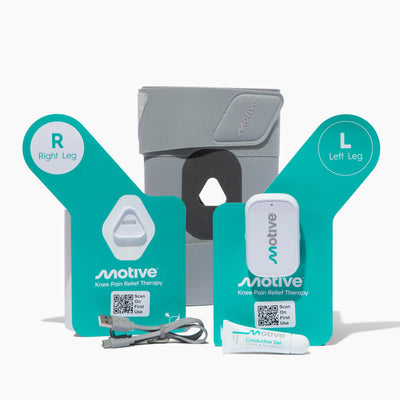
Knee pain affects millions of people around the world, from athletes in contact sports to those who experience discomfort from overuse or injury. The knee is one of the biggest and most complicated joints in the body and even a small injury can stop you in your tracks and limit your mobility.
In fact, knee injuries account for 41% of all injuries in sports, and are a common reason for people to seek medical attention.
The knee joint is made up of several key components:
- Bones (femur, tibia, patella)
- Ligaments (anterior cruciate ligament, posterior cruciate ligament, medial collateral ligament, and lateral collateral ligaments)
- Cartilage (meniscus)
In this article, we will go through the most common knee injuries, their causes, and treatment options to manage pain and regain mobility, including how Motive can help you.
Common Knee Injuries
Knee injuries are often caused by sudden movements, overuse, or direct impact.
If you’re an athlete or someone who leads an active lifestyle, understanding these injuries will help in early diagnosis and treatment.
Below are some of the most common knee injuries and their causes.
Osteoarthritis
Osteoarthritis is one of the most common causes of knee pain, especially for older adults and those with a history of joint stress. Osteoarthritis develops gradually as the cartilage wears out and the knee joint becomes inflamed.
Symptoms: People with knee osteoarthritis experience stiffness, swelling, and pain especially after periods of inactivity or heavy use. The cartilage in the knee joint wears out over time and the bones rub against each other causing discomfort and limited mobility.
Causes:
- Age
- Joint overuse
- Previous knee injuries
- Excess weight
Treatment Options: Although there isn’t a cure, you can manage your pain and improve your joint function. Low-impact exercises, physical therapy, and weight management are key to managing osteoarthritis. Over-the-counter anti-inflammatory medications or pain relievers can give short-term relief. In severe cases, assistive devices like knee braces or injections may be recommended by doctors.
ACL Tear
An ACL tear is a common knee injury, especially for athletes who play sports that involve sudden stops, jumps, or changes in direction.
Symptoms: ACL injuries are often accompanied by a loud pop at the time of injury, followed by swelling, severe knee pain, and instability in the knee. People with an ACL tear can’t put weight on the knee and the knee may give out during activities.
Causes:
- Sports-related incidents, especially in sports like soccer, basketball, or skiing
- Sudden changes of direction, pivoting, or landing awkwardly from a jump
- Contact sports increase the risk of sports injuries
Treatment Options: For partial tears, rest, physical therapy, and a knee brace may be enough. Complete ACL tears however may require surgical intervention to repair the ligament as well as an extensive rehabilitation program to regain strength and range of motion.
Meniscus Tear
A meniscal tear is a common orthopedic injury where the cartilage between the thigh bone (femur) and shinbone (tibia) is damaged. The menisci act as shock absorbers, cushioning the knee joint during movement.
Types of Meniscus Tears:
- Radial tears: A tear from the inner edge of the meniscus going outwards.
- Horizontal tears: A tear parallel to the tibia, often splitting the meniscus.
- Flap tears: An irregular tear resulting in a flap of cartilage.
- Bucket-handle tears: A major tear where a portion of the meniscus folds into the knee joint, causing severe locking or catching.
Symptoms: Meniscus tears cause knee pain, swelling, and stiffness. A person may also feel a pop during the injury. Common symptoms are difficulty bending or straightening the knee, limited range of motion and the knee feeling like it’s catching or locking.
Treatment Options: Minor tears may heal with rest, ice, and physical therapy, while larger tears often require surgical intervention such as arthroscopy to repair or remove the damaged part of the meniscus. Rehabilitation exercises after surgery can help regain knee strength and stability and lead to knee pain relief.
Patellar Tendinitis
Patellar tendonitis or “jumper’s knee” is an orthopedic overuse injury that affects the tendon that connects the kneecap (patella) to the shinbone (tibia). This condition is common in athletes who play sports that involve repetitive jumping like basketball or volleyball but can also affect those with high activity levels or those who suddenly increase their physical activity.
Causes:
- Repetitive stress on the patellar tendon
- Activities that involve frequent jumping, running, or squatting
- Muscle imbalances, tight quadriceps or hamstrings prior to the injury
- Poor technique or inadequate warm-up before physical activity
Symptoms:
- Pain below the kneecap especially during activity
- Tenderness when you press on the patellar tendon
- Swelling or stiffness in the knee joint
- Pain when jumping, running, or squatting
- Inability to fully extend the leg or kneel
Treatment Options:
- Rest and Ice: Reduce activity and apply ice to the impacted area to reduce inflammation.
- Physical Therapy: Focus on exercises that strengthen the quads, hamstrings, and calf muscles as well as gentle stretching exercises to help the tendon handle stress.
- Nonsteroidal Anti-Inflammatory Drugs (NSAIDs): Use over-the-counter meds like ibuprofen to reduce pain and swelling.
- Patellar Tendon Strap: A knee brace or strap used to reduce pressure on the tendon during activity.
- Advanced Treatments: For severe or chronic cases, Platelet-Rich Plasma therapy or corticosteroid injections may be recommended. In rare cases, surgery may be needed to repair the damaged tendon.
The Impact of Knee Injuries on Daily Life
Knee injuries, including complete tears of the anterior cruciate ligament (ACL), posterior cruciate ligament (PCL), medial collateral ligament (MCL), or lateral collateral ligament (LCL), can significantly impact your mobility and overall physical health, making it difficult to perform everyday activities like walking, climbing stairs, or standing for long periods.
If left untreated, knee pain can negatively impact your quality of life.
Mobility and Physical Activity
Knee injuries can lead to decreased mobility making it hard to do everyday activities or exercise. Tasks that were once easy – getting out of a chair, walking, or even carrying groceries – can become difficult and painful.
Those with severe injuries like ACL tears or meniscus tears may also need to use crutches or braces to support themselves, further reducing their independence.
Emotional and Psychological Toll
Chronic knee pain can have a big emotional and psychological impact. Living with constant discomfort can lead to frustration, anxiety, and even depression, especially when your knee pain interferes with work, hobbies or social life.
Being unable to be active due to knee injuries can lead to a loss of confidence, increased stress, and feelings of isolation.
Athletes in particular can face additional mental strain when knee injuries prevent them from doing their favorite sport or interfere with their career. Athletes who require knee replacement surgery or face severe torn ligaments or tendon tears often experience depression.
Acute to Chronic Pain
An acute knee injury (sprain or ligament tear) can become a long-term problem in some cases. Acute injuries can get worse over time and turn into chronic pain and inflammation if not treated correctly.
Inadequate rehabilitation, an early return to activity, or ignoring pain signals can all contribute to prolonging the injury and, in some cases, cause the knee joint’s range of motion and stability to decline even more.
Motive Knee: A Solution for Knee Pain
Motive Knee is a non-invasive therapy that relieves knee pain and improves joint stability. Whether you have a chronic condition like osteoarthritis or are recovering from an injury, Motive Knee can help you recover faster.
Motive targets one of the root causes of knee pain-muscle weakness by strengthening the quadriceps muscles. Stronger quadriceps support the knee joint, stabilize the patella (kneecap), and reduce stress on surrounding ligaments and tendons.
By strengthening the muscles and improving joint alignment, Motive helps you gain back your mobility and achieve lasting knee pain relief.
Using Motive alongside traditional treatments like physical therapy and other pain management options has several benefits.
Motive…
- Is an at-home solution that can easily fit into your daily routine.
- Uses advanced targeted muscle stimulation to strengthen key quad muscles, helping you recover faster and improve your knee function.
- Is a non-invasive, drug-free solution that promotes joint health and manages knee pain without major side-effects.
Prevention Strategies
By incorporating these strategies, you can reduce the risk of common knee injuries and maintain long-term joint stability.
- Warm-Up and Stretching: Always start with a proper warm-up to increase blood flow to the muscles and get the knee joint ready for physical activity. Use dynamic stretching exercises to target the quadriceps, hamstrings, and calf muscles to help improve flexibility and range of motion and reduce the risk of strains or ligament tears.
- Avoid Overuse: Repetitive movements and overuse can cause injuries like patellar tendinitis or ACL tears. Give your body time to rest and recover between activities, especially when doing high-impact sports like running or basketball that involve pivoting movements.
- Maintain a Healthy Weight: Excess body weight puts extra stress on the knee joint and increases the risk of osteoarthritis and other knee injuries. By maintaining a healthy weight, you reduce the stress on your knees and lower the risk of chronic joint pain.
- Strengthen Supporting Muscles: Strengthen the muscles around the knee, particularly the quads, hamstrings, and calves to provide more support to the joint. Add regular strengthening exercises like squats and lunges into your daily routine to improve knee stability and prevent ligament injuries like ACL and MCL tears.
Take Control of Your Knee Health with Motive
Knee pain can significantly impact your quality of life. Understanding the underlying causes, such as osteoarthritis or ACL tears, is crucial for effective recovery.
If you are struggling with knee pain, consult with a healthcare professional to get an accurate diagnosis and personalized treatment plan. Traditional approaches, such as physical therapy, can play a vital role in rehabilitation. Additionally, exploring complementary therapies like Motive Knee can offer additional benefits. Our non-invasive therapy focuses on strengthening the quadriceps muscles and enhancing overall knee stability, supporting a more complete recovery.
By actively engaging in your recovery journey and seeking appropriate medical advice, you can effectively manage knee pain and regain your mobility.
Take control of your knee health today with Motive’s innovative knee pain relief therapy.
Learn more and start your journey to recovery!





